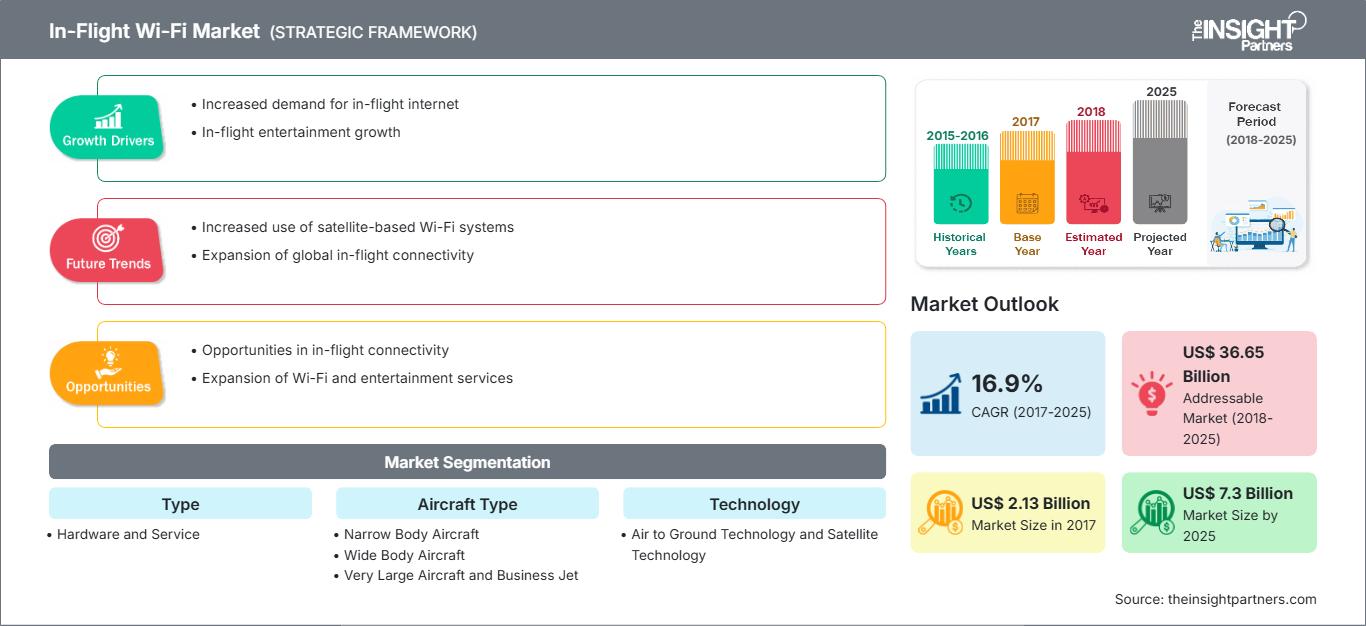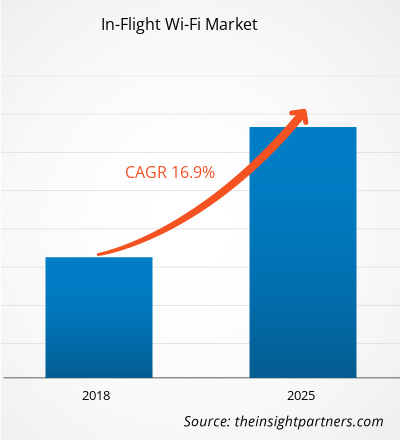2017年,机上Wi-Fi市场规模为21.3亿美元,预计到2025年将达到73亿美元;预计2018年至2025年期间的复合年增长率将达到16.9%。
在当今“时刻在线”的文化中,尤其是商务旅客,对航空公司在飞机上嵌入数字技术(包括机上连接选项)的期待日益高涨。乘客电子设备使用量的激增也明显提升了对机上连接的需求,尤其是在长途航班上。此外,由于航空公司本身面临着大幅增加额外收入的压力,机上连接(Wi-Fi)被认为是一种双赢策略,因为全球大多数乘客都愿意在飞行途中支付高速互联网连接费用。
小型航空公司也开始提供 Wi-Fi 服务,以吸引更多客户并与大型全球航空公司竞争。未来几年,机上 Wi-Fi 预计将提供更高的速度。例如,Inmarsat 等公司正在与其他公司合作,开发由地面塔支持的高容量卫星 Wi-Fi 网络。预计它将在空中提供一致的高带宽宽带服务。机上 Wi-Fi 市场的主要参与者之一 Gogo Inc. 承诺使用连接到卫星的双 Ku 波段天线将速度达到 70 Mbps。此外,卫星机上 Wi-Fi 技术预计将通过升级天线提供高达 70 Mbps 的速度。空地技术方面,预计运营商将机上Wi-Fi速度提升至100 Mbit/s。随着空地和卫星连接技术的进步,机上Wi-Fi预计将提供更快的速度、更佳的体验和最优的成本。由于连接速度的提高和航线数量的增加,机上Wi-Fi市场预计将在未来几年蓬勃发展。
自定义此报告以满足您的要求
您将免费获得任何报告的定制,包括本报告的部分内容,或国家级分析、Excel 数据包,以及为初创企业和大学提供超值优惠和折扣
机上Wi-Fi市场: 战略洞察

- 获取本报告的主要市场趋势。这个免费样本将包括数据分析,从市场趋势到估计和预测。
市场洞察——机上Wi-Fi市场与机上零售合作
您将免费获得任何报告的定制,包括本报告的部分内容,或国家级分析、Excel 数据包,以及为初创企业和大学提供超值优惠和折扣
机上Wi-Fi市场: 战略洞察

- 获取本报告的主要市场趋势。这个免费样本将包括数据分析,从市场趋势到估计和预测。
目前,在整体旅行支出中,机上零售仅占5%左右。得益于更佳的互联互通,航空公司现在为乘客提供机上零售购物服务。例如,瑞士航空和英国航空等航空公司允许乘客使用智能手机和平板电脑浏览和订购产品目录。此外,更佳的机上连接为乘客提供了更快、更简单、更安全的购物体验,这在以前是不可能实现的。许多航空公司已经开始与零售商合作,例如,中国国际航空已与在线零售商京东合作,提供送货上门服务和机上购物服务。汉莎航空与超市REWE合作宣布了一项项目,允许乘客使用机上Wi-Fi服务订购食品杂货,然后在乘客选择的时间将其运送到其家庭住址。因此,机上 Wi-Fi 连接为零售合作创造了机会,并促进了全球机上 Wi-Fi 市场的增长。
类型细分洞察
根据类型,机上 Wi-Fi 市场分为硬件和服务。硬件市场进一步细分为天线、无线局域网、接入点设备和热点网关。另一方面,服务细分为集成和实施服务、网络规划和设计服务、支持服务和其他。目前,航空公司运营商越来越倾向于在其窄体机、宽体机和公务机上部署 Wi-Fi 系统。这是由于对更高带宽的实时机上娱乐的需求不断增长。另一方面,服务市场多年来也在以相当快的速度增长,这涉及到定期维修和保养飞机上安装的 Wi-Fi 系统的需求。
飞机类型细分洞察
根据飞机类型,机上 Wi-Fi 市场细分为窄体飞机、宽体飞机、超大型飞机和公务机。这三种类型的飞机都安装了机上 Wi-Fi 系统,以提升乘客的旅行体验。在这三种类型的飞机中,窄体飞机大多配备了 Wi-Fi 系统,因为全球大多数航空公司的机队中都拥有大量窄体飞机。例如,已在其 100% 的机队中启用 Wi-Fi 系统的顶级航空公司包括冰岛航空、西南航空和维珍航空。西南航空拥有 716 架窄体飞机,而阿联酋航空拥有 256 架启用机上 Wi-Fi 的宽体飞机。这些统计数据展示了全球各地机上乘客对 Wi-Fi 系统的需求。
技术细分洞察
根据技术,机上 Wi-Fi 市场分为空对地技术和卫星技术。空对地机上 Wi-Fi 技术是航空公司使用最广泛的技术。这是因为其基础设施简单且成本低廉。另一方面,卫星技术提供更好、更高速的互联网,然而与空对地技术相比价格昂贵。这个因素限制了航空公司选择基于卫星的机上 Wi-Fi 系统。
市场参与者专注于新产品创新和开发,通过将先进的技术和功能集成到产品中来与竞争对手竞争。
2018 年:EchoStar 旗下的 Hughes 宣布增强其 JUPITER™系统,通过添加快速航路解析和优先级方案,为海事应用提供支持。2018年:Global Eagle Entertainment Inc.宣布,全日空贸易株式会社已授予Global Eagle一份为期三年的机上娱乐和内容服务合同。2018年:GOGO的2Ku机上连接解决方案被加拿大航空选为其庞巴迪CS300飞机。借助2Ku机上连接,加拿大航空将为其乘客提供在飞行途中工作、沟通和娱乐的能力。
机上 Wi-Fi 市场区域洞察
The Insight Partners 的分析师已详尽阐述了预测期内影响机上 Wi-Fi 市场的区域趋势和因素。本节还探讨了北美、欧洲、亚太地区、中东和非洲以及南美和中美洲的机上 Wi-Fi 市场细分和地域分布。
机上 Wi-Fi 市场报告范围
| 报告属性 | 细节 |
|---|---|
| 市场规模 2017 | US$ 2.13 Billion |
| 市场规模 2025 | US$ 7.3 Billion |
| 全球复合年增长率 (2017 - 2025) | 16.9% |
| 历史数据 | 2015-2016 |
| 预测期 | 2018-2025 |
| 涵盖的领域 |
By 类型
|
| 覆盖地区和国家 | 北美
|
| 市场领导者和主要公司简介 |
|
机上 Wi-Fi 市场参与者密度:了解其对业务动态的影响
机上 Wi-Fi 市场正在快速增长,这得益于终端用户需求的不断增长,而这些需求的驱动因素包括消费者偏好的演变、技术进步以及对产品优势的认知度的提升。随着需求的增长,企业正在扩展其产品线,不断创新以满足消费者需求,并抓住新兴趋势,从而进一步推动市场增长。

- 获取 机上Wi-Fi市场 主要参与者概述
全球机上 Wi-Fi 市场细分如下:
机上 Wi-Fi 市场 — 按类型
- 硬件
- 服务
机上 Wi-Fi 市场 — 按飞机类型
- 窄体飞机
- 宽体飞机
- 公务机
机上 Wi-Fi 市场 — 按技术
- 空对地
- 卫星
机上 Wi-Fi 市场 —
北美洲
- 美国
- 加拿大
- 墨西哥
欧洲
- 法国
- 德国
- 意大利
- 英国
- 俄罗斯
- 欧洲其他地区
亚太地区 (APAC)
- 中国
- 印度
- 韩国
- 日本
- 亚太地区其他地区
中东和非洲 (MEA)
- 南非
- MEA 其他地区
南美洲 (SAM)
- 巴西
- 阿根廷
- SAM 其他地区
机上 Wi-Fi 市场 – 公司简介
- Echostar Corporation
- Global Eagle Entertainment Inc
- Gogo LLC
- Honeywell International Inc
- Panasonic Avionics Corporation
- Viasat Inc
- Sitaonair
- Thales Group
- Thinkom Solutions Inc
- Kymeta Corporation
- 历史分析(2 年)、基准年、预测(7 年)及复合年增长率
- PEST和SWOT分析
- 市场规模、价值/数量 - 全球、区域、国家
- 行业和竞争格局
- Excel 数据集
近期报告
相关报告
客户评价
购买理由
- 明智的决策
- 了解市场动态
- 竞争分析
- 客户洞察
- 市场预测
- 风险规避
- 战略规划
- 投资论证
- 识别新兴市场
- 优化营销策略
- 提升运营效率
- 顺应监管趋势




















 获取免费样品 - 机上Wi-Fi市场
获取免费样品 - 机上Wi-Fi市场